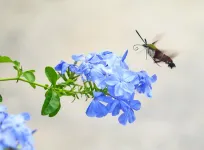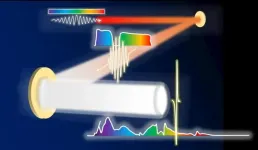(Press-News.org) GAINESVILLE, Fla. --- Entomologist Akito Kawahara's message is straightforward: We can't live without insects. They're in trouble. And there's something all of us can do to help.
Kawahara's research has primarily focused on answering fundamental questions about moth and butterfly evolution. But he's increasingly haunted by studies that sound the alarm about plummeting insect numbers and diversity.
Kawahara has witnessed the loss himself. As a child, he collected insects with his father every weekend, often traveling to a famous oak outside Tokyo whose dripping sap drew thousands of insects. It was there he first saw the national butterfly of Japan, the great purple emperor, Sasakia charonda. When he returned a few years ago, the oak had been replaced by a housing development. S. charonda numbers are in steep decline nationwide.
While scientists differ on the severity of the problem, many findings point to a general downward trend, with one study estimating 40% of insect species are vulnerable to extinction. In response, Kawahara has turned his attention to boosting people's appreciation for some of the world's most misunderstood animals.
"Insects provide so much to humankind," said Kawahara, associate curator at the Florida Museum of Natural History's McGuire Center for Lepidoptera and Biodiversity. "In the U.S. alone, wild insects contribute an estimated $70 billion to the economy every year through free services such as pollination and waste disposal. That's incredible, and most people have no idea."
Insects sustain flowering plants, the lynchpins of most land-based ecosystems, and provide food sources for birds, bats, freshwater fish and other animals. But they face a barrage of threats, including habitat loss, pesticides, pollution, invasive species and climate change. If human activities are driving the decline, Kawahara reasons, then people can also be a part of the solution.
In an opinion piece published in a special edition of the Proceedings of the National Academies of Sciences, Kawahara and his collaborators outline easy ways everyone can contribute to insect conservation.
Mow less
If you have a lawn, mowing less can give insect populations a boost. Kawahara suggests reserving 10% of a landscape for insects, either actively replacing a monoculture of grass with native plants or simply leaving the space unmown. These miniature nature preserves provide crucial habitat and food reservoirs for insects, he said, particularly if they remain free of chemical pesticides and herbicides. Benefits for lawn-maintainers include less yardwork and lower expenses.
"Even a tiny patch could be hugely important for insects as a place to nest and get resources," Kawahara said. "It's a stepping stone they can use to get from one place to another. If every home, school and local park in the U.S. converted 10% of lawn into natural habitat, this would give insects an extra 4 million acres of habitat."
If you don't have a lawn, you can still help by cultivating native plants in pots in window boxes or on balconies and patios.
Dim the lights
Nighttime light pollution has spiked since the 1990s, doubling in some of the world's most biodiverse places. Artificial lights are powerful attractants to nocturnal insects, which can exhaust themselves to death by circling bulbs or fall prey to predators that spot an easy target.
You can give insects a hand - and reduce your electric bill - by turning off unnecessary lights after dark and using amber or red bulbs, which are less attractive to insects.
Use insect-friendly soaps and sealants
Chemical pollutants in soaps for washing cars and building exteriors and in coal-tar-based driveway sealants can harm a variety of insect life. Kawahara recommends swapping these out for biodegradable soaps and soy-based sealants. In winter, trading rock salt for salt-free formulations is safer for both insects and pets.
Become an insect ambassador
In the U.S., insects have historically been depicted as devourers of crops, disease vectors and hallmarks of poor sanitation, even though the vast majority do not harm humans. Kawahara said rethinking your own stereotypes of insects and gaining a better understanding of their beauty, diversity and roles is a first step in helping others appreciate them, too.
He recalled leading schoolchildren on an insect-collecting trip during which a student found an elephant stag beetle, an enormous insect with massive jaws - "one of the coolest, most amazing bugs," Kawahara said.
The student wanted to step on the beetle, thinking it was a cockroach.
"Other students were grossed out, too," Kawahara said. "When I saw that, I was dumbfounded. If this was Japan, kids would be clamoring to be the first to get it and keep it as a pet. The juxtaposition of those cultural reactions was striking."
He pointed to media characterizations of Asian giant hornets - which he grew up seeing drink sap from the oak tree outside of Tokyo - as "murder hornets" as another example of how framing insects as dangerous or disgusting has the power to evoke strong reactions from the public.
As antidotes to unfounded fears, walk outdoors to look for local insect life or adopt pet insects, a simple, inexpensive way to introduce children to science, Kawahara said. Documenting what you see on platforms such as iNaturalist not only helps you learn more about your finds, but also provides data for scientific research.
These small steps have the power to effect immediate changes for the planet's insects, Kawahara said.
"The best way for change to happen quickly is for everyone to pitch in. As individuals, we can all do these kinds of activities right away."
INFORMATION:
Co-authors of the article are Lawrence Reeves of the University of Florida, Jesse Barber of Boise State University and a Florida Museum research associate, and Scott Black of the Xerces Society for Invertebrate Conservation.
MANHATTAN, KANSAS -- Kyle Goerl, the medical director of Kansas State University's Lafene Health Center, is part of a collaborative team that is providing research-based guidance during the COVID-19 pandemic. The team's latest research contributed to the updated quarantine guidance from the Centers for Disease Control and Prevention.
Goerl is a co-author of the publication "Time from Start of Quarantine to SARS-CoV-2 Positive Test Among Quarantined College and University Athletes." The publication appeared in the Morbidity and Mortality Weekly Report from the CDC on Friday, Jan. 8, and involved researchers from multiple organizations and universities.
The publication was one of many that the ...
Osaka, Japan -- Ultra-intense lasers with ultra-short pulses and ultra-high energies are powerful tools for exploring unknowns in physics, cosmology, material science, etc. With the help of the famous technology "Chirped Pulse Amplification (CPA)" (2018 Nobel Prize in Physics), the current record has reached 10 Petawatts (or 10^16 Watts). In a study recently published in Scientific Reports, researchers from Osaka University proposed a concept for next-generation ultra-intense lasers with a simulated peak power up to the Exawatt class (1 Exawatt equals 1000 Petawatts).
The laser, which was invented by Dr. T. H. Maiman in 1960, has one important characteristic of high intensity (or high peak power for pulse lasers): historically, laser peak ...
Scientists at Nanyang Technological University, Singapore (NTU Singapore) have developed insulin nanoparticles that may one day become the basis for an oral medicine, and an alternative to insulin injections for diabetic patients.
In a pre-clinical study, the NTU Singapore team fed insulin-containing nanoparticles to rats and found that insulin increased in their blood minutes later.
Insulin therapy is often an important part of treatment for diabetes, a metabolic disease that affects 422 million people globally . In Singapore, the number of diabetics is expected to grow to 1 million - almost a fifth of the population - in 2050 .
Delivering insulin orally would be preferable over insulin jabs for patients because it causes less ...
Anthropogenic, or human-made, heat flux in the near-surface atmosphere has changed urban thermal environments. Much of this fluctuation has been noted with rapid development of the global economy and urbanization since the turn of the 21st century. Meanwhile, the number of extreme temperature events in the first decade of the 21st century grew faster than in the last 10 years of the 20th century. During this period, urban extreme heat events have become more frequent, breaking temperature records more often.
"We found the relationships between anthropogenic heat flux and extreme temperature events..." said Prof. Zhenghui Xie, a scientist with the Institute of Atmospheric Physics, Chinese Academy of Sciences. "...including ...
DALLAS - Jan. 12, 2021 - A team of UT Southwestern researchers has identified a gene involved in the growth of breast cancer, a finding that could lead to potential new targets for treatment.
"The gene ZMYND8 is increased in breast cancer conditions, and higher levels of the gene correlate with poor survival of breast cancer patients," says Yingfei Wang, Ph.D., assistant professor of pathology and neurology and corresponding author of the new study, published in Cancer Research. "It could be a promising target for antitumor immunotherapy."
In the U.S., about 1 in 8 women will develop breast cancer at some point in their life. Worldwide, breast cancer is the most common cancer ...
In a paper published in Molecular Frontiers Journal, researchers from Cambridge, Massachusetts and Bangalore, India study the effectiveness of FEND product to significantly improve airway hygiene by reducing and suppressing respiratory droplets potentially containing airborne pathogens and other contaminants. The study's findings further highlight why the FEND product is an important new daily hygiene protocol that joins century-old hand washing, masking and distancing measures as a fourth protective layer of defense against aerosolized particles.
The new study examined two nasal salines: ...
CORVALLIS, Ore. - A resemblance to moss, lichens and fungi made for fantastic cover by a new genus and species of cylindrical bark beetle described by an Oregon State University College of Science researcher.
"If you can't beat your enemies or run away, then hide, and that is what this Cretaceous beetle is doing," said OSU's George Poinar Jr. "He is hiding under a spectacular camouflage of his own making, allowing him to blend into a mossy background."
Poinar, an international expert in using plant and animal life forms preserved in amber to learn more about the biology and ecology of the distant past, and collaborator Fernando ...
Research on cycad trees in Colombia, Guam, and the Philippines has illuminated how knowledge of their branching behavior may benefit conservation decisions for the endangered plants. In a study published in the December issue of the journal Horticulturae, scientists from the University of Guam and the Montgomery Botanical Center in Florida show that the number of times a cycad tree produces a branch can be used to infer the sex of the tree. The findings have practical applications for use of the sexual dimorphism that is described.
Cycads are unique seed-producing plants. Conservation actions are being implemented for many species around the world as cycads are being threatened by human activity.
The arborescent cycad stem is constructed using ...
Ten years of data from Australia, New Zealand and Canada reveals a drop in drowning deaths among people under 20 - but a large increase in drowning for adolescent females and First Nations peoples.
Associate Professor Richard Franklin from James Cook University in Queensland, Australia, said an international collaboration of researchers looked at drowning in the under 20s between 2005 and 2014.
"Globally, drowning is a leading cause of unintentional death among children and young people, with the greatest toll among children under the age of five years. Many more children are impacted by non-fatal drowning, some experiencing long-term health impacts," said Dr Franklin.
He said children aged 0-19 years account for an average ...
PHILADELPHIA--Patient-reported outcomes have become a critical part of improving surgical care because of their ability to capture patient experiences, such as quality of life and satisfaction, that can help inform treatment. However, for patients undergoing abdominal hernia repair -- a common procedure performed on about 400,000 patients a year in the United States -- a tool to effectively and practically measure those outcomes has not been widely accepted and implemented by clinics.
Now, researchers from the division of Plastic Surgery in the department of Surgery in the Perelman School of Medicine at the University of Pennsylvania, have successfully developed, tested, and implemented a first-of-its-kind, patient-informed ...







